How Exceptional Was the 2023–2024 Flood Sequence in the Charente River (Aquitania, South-West France)? A Geohistorical Perspective on Clustered Floods
Abstract
1. Introduction
2. Study Area
2.1. The Charente River
2.2. The Charente River Floods Regime
2.3. The 2023–2024 Floods Sequence
2.3.1. The November 2023 Flood
2.3.2. The December 2023 Flood
2.3.3. The February–March 2024 Flood
2.3.4. The March–April 2024 Flood
3. Materials and Methods
3.1. Meteorological Data
3.2. Hydrological Data
3.3. Documentary Sources
3.3.1. Secondary Sources
3.3.2. Historical Archives
3.3.3. Newspapers
3.3.4. Iconography
3.3.5. Epigraphic Records
3.4. Processing of Historical Data
3.4.1. Historical Data Gathering
3.4.2. Flood Chronology
3.4.3. Classification of Flood Events
4. Results
5. Discussion
6. Conclusions
Author Contributions
Funding
Data Availability Statement
Acknowledgments
Conflicts of Interest
References
- Howe, J.; White, I. The Geography of the Autumn 2000 Floods in England and Wales: Causes and Solutions. Geography 2002, 87, 116–124. [Google Scholar] [CrossRef]
- Marsh, T.J. A hydrological overview of the summer 2007 floods in England and Wales. Weather 2008, 63, 274–279. [Google Scholar] [CrossRef]
- Marsh, T.J.; Hannaford, J. The Summer 2007 Floods in England and Wales—A Hydrological Appraisal; Centre for Ecology & Hydrology: Lancaster, UK, 2007; p. 32. [Google Scholar]
- Kay, A.L.; Crooks, S.M.; Pall, P.; Stone, D.A. Attribution of Autumn/Winter 2000 flood risk in England to anthropogenic climate change: A catchment-based study. J. Hydrol. 2011, 406, 97–112. [Google Scholar] [CrossRef]
- Ulbrich, U.; Brücher, T.; Fink, A.H.; Leckebusch, G.C.; Krüger, A.; Pinto, J.G. The central European floods of August 2002: Part 1—Rainfall periods and flood development. Weather 2003, 58, 371–377. [Google Scholar] [CrossRef]
- Ulbrich, U.; Brücher, T.; Fink, A.H.; Leckebusch, G.C.; Krüger, A.; Pinto, J.G. The central European floods of August 2002: Part 2—Synoptic causes and considerations with respect to climatic change. Weather 2003, 58, 434–441. [Google Scholar] [CrossRef]
- ICPDR. The Analysis of the Danube Floods 2006; International Commission for the Protection of the Danube River: Vienna, Austria, 2008. [Google Scholar]
- ICPDR. Floods in June 2013 in the Danube River Basin. Brief Overview of Key Events and Lessons Learned; International Commission for the Protection of the Danube River: Vienna, Austria, 2014. [Google Scholar]
- Lehmkuhl, F.; Schüttrumpf, H.; Schwarzbauer, J.; Brüll, C.; Dietze, M.; Letmathe, P.; Völker, C.; Hollert, H. Assessment of the 2021 summer flood in Central Europe. Environ. Sci. Eur. 2022, 34, 107. [Google Scholar] [CrossRef]
- Faranda, D.; Bourdin, S.; Ginesta, M.; Krouma, M.; Noyelle, R.; Pons, F.; Yiou, P.; Messori, G. A climate-change attribution retrospective of some impactful weather extremes of 2021. Weather Clim. Dynam. 2022, 3, 1311–1340. [Google Scholar] [CrossRef]
- Kron, W.; Bell, R.; Thiebes, B.; Thieken, A.H. The July 2021 flood disaster in Germany. In HELP Global Report on Water and Disasters 2022; Secretariat of the High-level Experts and Leaders Panel on Water and Disasters (HELP): Tokyo, Japan, 2022; Chapter 2; pp. 12–44. Available online: https://www.wateranddisaster.org/category/documents/ (accessed on 3 November 2024).
- Thieken, A.H.; Bubeck, P.; Heidenreich, A.; von Keyserlingk, J.; Dillenardt, L.; Otto, A. Performance of the flood warning system in Germany in July 2021—Insights from affected residents. Nat. Hazards Earth Syst. Sci. 2023, 23, 973–990. [Google Scholar] [CrossRef]
- ClimaMeter. Available online: https://www.climameter.org/20231020-20231121-france-italy-floods (accessed on 3 November 2024).
- Brázdil, R.; Kundzewicz, Z.W.; Benito, G. Historical hydrology for studying flood risk in Europe. Hydrol. Sci. J. 2006, 51, 739–764. [Google Scholar] [CrossRef]
- PPS 25 (Planning Policy Statement 25). Development and Flood Risk; Communities and Local Government, HMSO: Norwich, UK, 2006; p. 50. [Google Scholar]
- Brázdil, R.; Dobrovolný, P.; Elleder, L.; Kakos, V.; Kotyza, O.; Kveton, V.; Macková, J.; Müller, M.; Štekl, J.; Tolasz, R.; et al. Historical and Recent Floods in the Czech Republic; Masaryk University: Brno, Czech Republic; Czech Hydrometeorological Institute: Prague, Czech Republic, 2005; p. 369. [Google Scholar]
- Merz, B.; Blóschl, G.; Vorogushyn, S.; Dottori, F.; Aerts, J.; Bates, P.; Bertola, M.; Kemter, M.; Kreibich, H.; Lall, U.; et al. Causes, impacts and patterns of disastrous river floods. Nat. Rev. Earth Environ. 2021, 2, 592–609. [Google Scholar] [CrossRef]
- Lang, M.; Moussay, D.; Recking, A.; Naulet, R. Hydraulic modelling of historical floods: A case study on the Ardeche river at Vallon-Pont-D’arc. In Palaeofloods, Historical Data & Climatic Variability: Applications in Flood Risk Assessment, Proceedings of the PHEFRA International Workshop, Barcelona, Spain, 16–19 October 2002; Thorndycraft, V.R., Benito, G., Barriendos, M., Llasat, C., Eds.; CSIC: Madrid, Spain, 2003; pp. 183–189. [Google Scholar]
- Ngo, H.; Bomers, A.; Augustijn, D.C.M.; Ranasinghe, R.; Filatova, T.; van der Meulen, B.; Herget, J.; Hulscher, S.J.M.H. Reconstruction of the 1374 Rhine river flood event around Cologne region using 1D-2D coupled hydraulic modelling approach. J. Hydrol. 2023, 617, 129039. [Google Scholar] [CrossRef]
- Van der Meulen, B.; Bomers, A.; Cohen, K.M.; Middlekoop, H. Late Holocene flood magnitudes in the Lower Rhine river valley and upper delta resolved by a two-dimensional hydraulic modelling approach. Earth Surf. Proc. Land. 2021, 46, 853–868. [Google Scholar] [CrossRef]
- Barriendos, M.; Coeur, D.; Lang, M.; Llasat, M.C.; Naulet, R.; Lemaitre, F.; Barrera, A. Stationarity analysis of historical flood series in France and Spain (14th–20th centuries). Nat. Hazards Earth Syst. Sci. 2003, 3, 583–592. [Google Scholar] [CrossRef]
- Benito, G.; Díez-Herrero, A.; Fernández De Villalta, M. Magnitude and frequency of flooding in the Tagus basin (Central Spain) over the last millennium. Clim. Change 2003, 58, 171–192. [Google Scholar] [CrossRef]
- Glaser, R.; Riemann, D.; Schönbein, J.; Barriendos, M.; Brázdil, R.; Bertolin, C.; Himmelsbach, I. The variability of European floods since AD 1500. Clim. Change 2010, 101, 235–256. [Google Scholar] [CrossRef]
- Blöschl, G.; Kiss, A.; Viglione, A.; Barriendos, M.; Böhm, O.; Brázdil, R.; Coeur, D.; Demarée, G.; Llasat, M.C.; Macdonald, N.; et al. Current European flood-rich period exceptional compared with past 500 years. Nature 2020, 583, 560–566. [Google Scholar] [CrossRef]
- Hall, J.; Arheimer, B.; Borga, M.; Brázdil, R.; Claps, P.; Kiss, A.; Kjeldsen, T.R.; Kriaucīuniene, J.; Kundzewicz, Z.W.; Lang, M.; et al. Understanding flood regime changes in Europe: A state-of-the-art assessment. Hydrol. Earth Syst. Sci. 2014, 18, 2735–2772. [Google Scholar] [CrossRef]
- Macdonald, N. Trends in flood seasonality of the River Ouse (northern England), from archive and instrumental sources since AD 1600. Clim. Change 2012, 110, 901–923. [Google Scholar] [CrossRef]
- Macdonald, N.; Black, A.R. Reassessment of flood frequency using historical information for the River Ouse at York, UK, (1200–2000). Hydrolog. Sci. J. 2010, 55, 1152–1162. [Google Scholar] [CrossRef]
- Macdonald, N.; Sangster, H. High-magnitude flooding across Britain since AD 1750. Hydrol. Earth Syst. Sci. 2017, 21, 1631–1650. [Google Scholar] [CrossRef]
- Macdonald, N.; Black, A.R.; Werritty, A.; McEwen, L.J. Historical and pooled flood frequency analysis for the River Tay at Perth, Scotland. Area 2006, 38, 34–46. [Google Scholar] [CrossRef]
- Brázdil, R.; Řezníčková, L.; Valášek, H.; Havlíček, M.; Dobrovolný, P.; Soukalová, E.; Řehánek, T.; Skokanová, H. Fluctuations of floods of the River Morava (Czech Republic) in A.D. 1691–2009: Interactions of natural and anthropogenic factors. Hydrolog. Sci. J. 2011, 56, 468–485. [Google Scholar] [CrossRef]
- Brázdil, R.; Faturová, D.; Šulc Michalková, M.; Řehoř, J.; Caletka, M.; Zahradníček, P. Spatiotemporal variability of flash floods and their human impacts in the Czech Republic during the 2001–2023 period. Nat. Hazards Earth Syst. Sci. 2024, 24, 3663–3682. [Google Scholar] [CrossRef]
- Brázdil, R.; Kotyza, O.; Dobrovolný, P. July 1432 and August 2002—Two millennial floods in Bohemia? Hydrol. Sci. J. 2006, 51, 848–863. [Google Scholar] [CrossRef]
- Mudelsee, M.; Börngen, M.; Tetzlaff, G.; Grünewald, U. No upward trends in the occurrence of extreme floods in central Europe. Nature 2003, 425, 166–169. [Google Scholar] [CrossRef]
- Mudelsee, M.; Deutsch, M.; Börngen, M.; Tetzlaff, G. Trends in flood risk of the River Werra (Germany) over the past 500 years. Hydrol. Sci. J. 2006, 51, 818–833. [Google Scholar] [CrossRef]
- Glaser, R.; Stangl, H. Climate and floods in Central Europe since AD 1000: Data, methods, results and consequences. Surv. Geophys. 2004, 25, 485–510. [Google Scholar] [CrossRef]
- Toonen, W.H.J.; Winkels, T.G.; Cohen, K.M.; Prins, M.A.; Middelkoop, H. Lower Rhine historical flood magnitudes of the last 450 years reproduced from grain-size measurements of flood deposits using End Member Modelling. Catena 2015, 130, 69–81. [Google Scholar] [CrossRef]
- Burger, K.; Dostal, P.; Seidel, J.; Imbery, F.; Barriendos, M.; Mayer, H.; Glaser, R. Hydrometeorological reconstruction of the 1824 flood event in the Neckar River basin (southwest Germany). Hydrol. Sci. J. 2006, 51, 864–877. [Google Scholar] [CrossRef]
- Tol, R.S.J.; Langen, A. A concise history of Dutch river floods. Clim. Change 2000, 46, 357–369. [Google Scholar] [CrossRef]
- Wetter, O.; Pfister, C.; Weingartner, R.; Luterbacher, J.; Reist, T.; Trösch, J. The largest floods in the High Rhine basin since 1268 assessed from documentary and instrumental evidence. Hydrolog. Sci. J. 2011, 56, 733–758. [Google Scholar] [CrossRef]
- Wetter, O. The potential of historical hydrology in Switzerland. Hydrol. Earth Syst. Sci. 2017, 21, 5781–5803. [Google Scholar] [CrossRef]
- Llasat, M.C.; Barriendos, M.; Barrera, A.; Rigo, T. Floods in Catalonia (NE Spain) since the 14th century. Climatological and meteorological aspects from historical documentary sources and old instrumental records. J. Hydrol. 2005, 313, 32–47. [Google Scholar] [CrossRef]
- Barriendos, M.; Rodrigo, F.S. Study of historical flood events on Spanish river using documentary data. Hydrol. Sci. J. 2006, 51, 765–783. [Google Scholar] [CrossRef]
- Sánchez-García, C.; Schulte, L.; Peña, J.C.; Carvalho, F.; Brembilla, C. A 500-year history of floods in the semiarid basins of south-eastern Spain. Geophys. Res. Abstr. 2016, 18, 104317. [Google Scholar]
- Sánchez-García, C.; Schulte, L.; Carvalho, F.; Peña, J.C. A 500-year flood history in the arid environments of southeastern Spain. The case of the Almanzora River. Global Planet. Change 2019, 181, 102987. [Google Scholar] [CrossRef]
- Sánchez-García, C.; Schulte, L. Historical floods in the southeastern Iberian Peninsula since the 16th century: Trends and regional analysis of extreme flood events. Global Planet. Change 2023, 231, 104317. [Google Scholar] [CrossRef]
- Engeland, K.; Aano, A.; Steffensen, I.; Støren, E.; Paasche, Ø. New flood frequency estimates for the largest river in Norway based on the combination of short and long time series. Hydrol. Earth Syst. Sci. 2020, 24, 5595–5619. [Google Scholar] [CrossRef]
- Engeland, K.; Wilson, D.; Borsányi, P.; Roald, L.; Holmqvist, E. Use of historical data in flood frequency analysis: A case study for four catchments in Norway. Hydrol. Res. 2018, 49, 466–486. [Google Scholar] [CrossRef]
- Hardeng, J.; Bakke, J.; Cederstrøm, J.M.; Forsmo, J.; Haugen, T.A.; Sabatier, P.; Støren, N.; Wilhelm, E.; van der Bilt, W.G.M. A 7000-year record of extreme flood events reconstructed from a threshold lake in southern Norway. Quat. Sci. Rev. 2024, 331, 108659. [Google Scholar] [CrossRef]
- Reghezza-Zitt, M. Paris Coule-t-il? Fayard: Paris, France, 2012; p. 350. [Google Scholar]
- Dacharry, M. Les grandes crues historiques de la Loire. Houille Blanche 1996, 6–7, 47–53. [Google Scholar] [CrossRef]
- Ramond, S. Réponses Hydrologiques de la Loire Moyenne aux Changements Environnementaux. Formation des Débits et Fonctionnement d’une Plaine Alluviale: Approches Hydrologiques et Géochimiques Multi-Scalaire. Ph.D. Thesis, École Doctorale Sciences Sociales, Paris, France, 2015. [Google Scholar]
- Mesmin, E.; Gautier, E.; Arnaud-Fassetta, G.; Foucher, M.; Martins, G.; Gob, F. Characterization of periods of high and low hydrological activity in the Loire River, France, between the 14th and mid-19th centuries. J. Hydrol. 2024, 633, 130932. [Google Scholar] [CrossRef]
- Pichard, G.; Roucaute, É. Sept siècles d’histoire hydroclimatique du Rhône d’Orange à la mer (1300-2000), climat, crues, inondations, Georges PICHARD et Émeline ROUCAUTE, 2014. Physio-Géo 2014, 9, 192. [Google Scholar]
- Pichard, G.; Arnaud-Fassetta, G.; Moron, V.; Roucaute, E. Hydro-climatology of the lower Rhône Valley: Historical flood reconstruction (AD 1300–2000) based on documentary and instrumental sources. Hydrol. Sci. J. 2017, 62, 1772–1795. [Google Scholar] [CrossRef]
- Toonen, W.H.J.; Middelkoop, H.; Konijnendijk, T.Y.M.; Macklin, M.G.; Cohen, K.M. The influence of hydroclimatic variability on flood frequency in the Lower Rhine. Earth Surf. Process. Landf. 2016, 41, 1266–1275. [Google Scholar] [CrossRef]
- Antoine, J.M.; Desailly, B. Base de Données Historiques sur les Inondations de la Cèze, des Gardons, du Vidourle et de l’Hérault dans le Département du Gard (XIIIe Siècle-XXe Siècle); Départementale de l’Equipement du Gard: Nîmes, France, 1994; 264p. [Google Scholar]
- Antoine, J.M.; Desailly, B.; Gazelle, F. Les crues meurtrières, du Roussillon aux Cévennes. Ann. Géographie 2001, 110, 597–623. [Google Scholar] [CrossRef]
- Blanchemanche, P. Crues historiques et vendanges en languedoc méditerranéen oriental: La source, le signal et l’interprétation. Archéol. Midi Médiév. 2009, 27, 225–235. [Google Scholar] [CrossRef]
- Berger, J.F.; Blanchemanche, P.; Reynès, C.; Sabatier, P. Dynamiques fluviales en basse vallée du vidourle au cours des six derniers siècles. confrontation des données pédosédimentaires à haute résolution temporelle à l’analyse fréquentielle des crues historiques. Quaternaire 2010, 21, 27–41. [Google Scholar] [CrossRef][Green Version]
- Desailly, B. Crues et inondations en Roussillon. Le risque et l’aménagement. Rev. Géogr. Pyrén. Sud-Ouest 1990, 61, 515–519. [Google Scholar] [CrossRef]
- Antoine, J.M. Géohistoire des Catastrophes et des Risques Torrentiels. Une Histoire de l’Environnement Pyrénéen; Postdoctoral Report; Université Toulouse Le Mirail (Toulouse II): Toulouse, France, 2010. [Google Scholar]
- Antoine, J.M. Vulnérabilité et adaptation des sociétés montagnardes à la torrentialité au cours du petit âge glaciaire dans les pyrénées. Sud-Ouest Eur. 2011, 32, 53–66. [Google Scholar] [CrossRef]
- Miramont, C.; Guilbert, X. Variations historiques de la fréquence des crues et évolution de la morphogenèse fluviale en moyenne durance (France du Sud-Est). Géomorphologie 1997, 3, 325–337. [Google Scholar] [CrossRef]
- Cœur, D. La Plaine de Grenoble face aux Inondations: Genèse d’une Politique Publique du XVIIe au XXe Siècle; Quae: Versailles, France, 2008; p. 329. [Google Scholar]
- Wilhelm, B.; Arnaud, F.; Sabatier, P.; Magand, O.; Chapron, E.; Courp, T.; Tachikawa, K.; Fanget, B.; Malet, E.; Pignol, C.; et al. Palaeoflood activity and climate change over the last 1400 years recorded by lake sediments in the north-west European Alps. J. Quat. Sci. 2013, 28, 189–199. [Google Scholar] [CrossRef]
- Wilhelm, B.; Rapuc, W.; Amann, B.; Anselmetti, F.S.; Arnaud, F.; Blanchet, J.; Brauer, A.; Czymzik, M.; Giguet-Covex, C.; Gilli, A.; et al. Impact of warmer climate periods on flood hazard in the european Alps. Nat. Geosci. 2022, 15, 118–123. [Google Scholar] [CrossRef]
- Naulet, R. Utilisation de l’Information des Crues Historiques pour une Meilleure Prédétermination du Risque d’Inondation: Application au Bassin de l’Ardèche à Vallon Pont-d’Arc et St-Martin d’Ardèche. Ph.D. Thesis, Université Joseph Fourier (Grenoble I), Saint-Martin-d’Hères, France, 2002. [Google Scholar]
- Naulet, R.; Lang, M.; Ouarda, T.B.; Coeur, D.; Bobée, B.; Recking, A.; Moussay, D. Flood frequency analysis on the Ardèche river using French documentary sources from the two last centuries. J. Hydrol. 2005, 313, 58–78. [Google Scholar] [CrossRef]
- With, L. Approche Géohistorique de la Gestion et de la Prévention du Risque d’Inondation: Le Cas de la Vallée de la Lauch (Haut-Rhin) de 1778 à nos Jours. Ph.D. Thesis, Université de Haute-Alsace, Mulhouse, France, 2014. [Google Scholar]
- With, L. Approche géohistorique de la gestion et de la prévention du risque d’inondation: Le cas de la vallée de la Lauch (Haut-Rhin) de 1778 à nos jours. Actes des Séminaires CRESAT 2015, 12, 127–142. [Google Scholar]
- Martin, B.; Holleville, N.; Furst, B.; Giacona, F.; Glaser, R.; Himmelsbach, I.; Schönbein, J. La géohistoire des inondations au service de l’évaluation critique du zonage du Plan de Prévention des Risques d’Inondation: L’exemple de Thann (Haut-Rhin, France). Belgeo 2015, 1, 1–16. [Google Scholar] [CrossRef]
- Martin, B.; Giacona, F.; Furst, B.; Edelblutte, C.; Glaser, R.; Himmelsbach, I.; Holleville, N.; Schönbein, J.; Heitz, C.; Bossmeier, A. La variabilité spatio-temporelle des inondations dans le Fossé rhénan à la lumière de l’évolution de la vulnérabilité. VertigO 2017, 17, 1–23. [Google Scholar]
- Martin, B.; Giacona, F.; With, L.; Edelblutte, C.; Furst, B.; Holleville, N.; Vitoux, M.C.; Glaser, R.; Himmelsbach, I.; Schönbein, J.; et al. Concepts, Méthodes et Opérationnalité en Géohistoire des Risques, à Travers l’Exemple de la Géohistoire des Inondations dans le Fossé Rhénan; CNRS Éditions: Paris, France, 2019; pp. 279–300. [Google Scholar]
- Lespez, L.; Germaine, M.A.; Barraud, R. L’évaluation par les services écosystémiques des rivières ordinaires est-elle durable? VertigO 2016, 25, 1–20. [Google Scholar]
- Duquesne, A.; Carozza, J.M. Ecrire la géohistoire d’un fleuve à faible énergie: Les crues de la Charente entre Angoulême et Saintes. Physio-Géo–Géographie Phys. Environ. 2019, 14, 57–86. [Google Scholar] [CrossRef]
- IPCC. Climate Change 2021: The Physical Science Basis. Contribution of Working Group I to the Sixth Assessment Report of the Intergovernmental Panel on Climate Change; Masson-Delmotte, V., Zhai, P., Pirani, A., Connors, S.L., Péan, C., Berger, S., Caud, N., Chen, Y., Goldfarb, L., Gomis, M.I., et al., Eds.; Cambridge University Press: Cambridge, UK; New York, NY, USA, 2021; p. 2391. [Google Scholar]
- Seneviratne, S.I.; Zhang, X.; Adnan, M.; Badi, W.; Dereczynski, C.; Di Luca, A.; Ghosh, S.; Iskandar, I.; Kossin, J.; Lewis, S.; et al. Weather and Climate Extreme Events in a Changing Climate. In Climate Change 2021: The Physical Science Basis. Contribution of Working Group I to the Sixth Assessment Report of the Intergovernmental Panel on Climate Change; Masson-Delmotte, V., Zhai, P., Pirani, A., Connors, S.L., Péan, C., Berger, S., Caud, N., Chen, Y., Goldfarb, L., Gomis, M.I., et al., Eds.; Cambridge University Press: Cambridge, UK; New York, NY, USA, 2021; pp. 1513–1766. [Google Scholar]
- Ranasinghe, R.; Ruane, A.C.; Vautard, R.; Arnell, N.; Coppola, E.; Cruz, F.A.; Dessai, S.; Islam, A.S.; Rahimi, M.; Carrascal, D.R.; et al. Chapter 12: Climate change information for regional impact and for risk assessment. In Climate Change 2021: The Physical Science Basis. Contribution of Working Group I to the Sixth Assessment Report of the Intergovernmental Panel on Climate Change; Masson-Delmotte, V., Zhai, P., Pirani, A., Connors, S.L., Péan, C., Berger, S., Caud, N., Chen, Y., Goldfarb, L., Gomis, M.I., et al., Eds.; Cambridge University Press: Cambridge, UK; New York, NY, USA, 2021; pp. 1767–1926. [Google Scholar]
- Carozza, J.M.; Duquesne, A.; Vayssière, A. L’anastomose du fleuve Charente: Apports de la quantification des formes fluviales à la connaissance des processus géomorphologiques et des facteurs de contrôle. Géomorphologie Relief Process. Environ. 2023, 29, 5–23. [Google Scholar] [CrossRef]
- Nanson, G.C. Anabranching and anastomosing rivers. Treatise Geomorphol. 2013, 9, 330–345. [Google Scholar]
- Duquesne, A.; Plumejeaud-Perreau, C.; Carozza, J.M. Trajectoire d’évolution d’un cours d’eau à très faible énergie: Le cas de la Charente entre Angoulême et Saintes (Ouest de la France). Géomorphologie Relief Process. Environ. 2020, 26, 97–115. [Google Scholar] [CrossRef]
- Duquesne, A. Trajectoire d’Évolution d’un Cours d’Eau à Faible Énergie au Cours du Second Holocène: Le Fleuve Charente entre Angoulême et Saintes. Ph.D. Thesis, La Rochelle Université, La Rochelle, France, 2021. [Google Scholar]
- Duquesne, A.; Plumejeaud-Perreau, C.; Carozza, J.M. Trajectoire Trajectoire d’évolution des îles fluviales d’un cours d’eau anastomosé à faible énergie: L’exemple de la Charente entre Angoulême et Saintes (ouest de la France). In Géohistoire des Zones Humides. Trajectoire d’Artificialisation et de Conservation; Valette, P., Burens, A., Carozza, L., Cristian, M., Eds.; Presses Universitaires Du Midi: Toulouse, France, 2024; pp. 97–126. [Google Scholar]
- Enjalbert, H. La vallée moyenne de la Charente. Esquisse Morphol. Ann. Géographie. 1952, 61, 16–33. [Google Scholar] [CrossRef]
- Bourgueil, B. Évolution de la transgression flandrienne et du littoral charentais depuis 8500 BP. Géol. Fr. 2005, 1, 75–84. [Google Scholar]
- Bry, C.; Hoflack, P. Le bassin versant de la Charente: Une illustration des problèmes posés par la gestion quantitative de l’eau. Courr. Environ. INRA 2004, 52, 81–96. [Google Scholar]
- HydroPortail. Available online: https://www.hydro.eaufrance.fr/ (accessed on 24 November 2024).
- DREAL Poitou-Charentes. Rapport de Présentation de la Cartographie du Risque d’Inondation de la Charente sur le Secteur de Saintes-Cognac-Angoulême; DREAL Occitanie: Montpellier, France, 2014. [Google Scholar]
- Direction Départementale des Territoires et de la Mer. Révision des PPRI des Communes Riveraines de la Charente, de Saintes à la Limite Amont du Département—Commune de Saintes—Note de Présentation; Départementale des Territoires et de la Mer: Saintes, France, 2011. [Google Scholar]
- EPTB Charente (The Website e-crue). Available online: http://www.fleuve-charente.net/les-donnees-sur-leau/suivi-des-crues/la-plateforme-e-crue (accessed on 4 November 2024).
- Météo-France. Available online: https://www.data.gouv.fr/fr/organizations/meteo-france/#/datasets (accessed on 4 November 2024).
- Wetterzentrale. Available online: https://www.wetterzentrale.de/ (accessed on 4 November 2024).
- Slivinski, L.C.; Compo, G.P.; Whitaker, J.S.; Sardeshmukh, P.D.; Giese, B.S.; McColl, C.; Allan, R.; Yin, X.; Vose, R.; Titchner, H.; et al. Towards a more reliable historical reanalysis: Improvements for version 3 of the Twentieth Century Reanalysis system. Q. J. R. Meteorol. Soc. 2019, 145, 2876–2908. [Google Scholar] [CrossRef]
- Société des Archives Historiques. Bulletin de la Société des Archives Historiques—Revue de la Saintonge et de l’Aunis; Société des Archives Historiques: Saintes, France, 1904; Volume 24, p. 513. [Google Scholar]
- Champion, M. Les Inondations en France du VIe Siècle à nos Jours; Dunod: Paris, France, 1863; Volume 5, pp. 197–204. [Google Scholar]
- RetroNews. Available online: https://www.retronews.fr/ (accessed on 4 November 2024).
- La Source—Portail des Archives de la Charente. Available online: https://lasource.archives.lacharente.fr/archive/egf/FRAD016-CC-OpinionsPresse/n:142 (accessed on 4 November 2024).
- Vigicrues. Available online: https://www.reperesdecrues.developpement-durable.gouv.fr/ (accessed on 4 November 2024).
- Lang, M.; Ouarda, T.B.M.J.; Bobée, B. Towards operational guidelines for over-threshold modeling. J. Hydrol. 1999, 225, 103–117. [Google Scholar] [CrossRef]
- Robson, A.J.; Reed, D.W. Statistical Procedures for Flood Frequency Estimation; Volume 3 of the Flood Estimation Handbook; Centre for Ecology and Hydrology: Bailrigg, UK, 1999; pp. 273–283. [Google Scholar]
- Barriendos, M.; Coeur, D. Flood data reconstruction in historical times from non-instrumental sources in Spain and France. In Use of Systematic, Palaeoflood and Historical Data for the Improvement of Flood Risk Estimation. Methodological Guidelines; Benito, G., Thorndycraft, V.R., Eds.; Centro de Ciencias Medioambientales: Madrid, Spain, 2004; pp. 29–42. [Google Scholar]
- Jones, P.D.; Jonsson, T.; Wheeler, D. Extension to the North Atlantic oscillation using early instrumental pressure observations from Gibraltar and south-west Iceland. Int. J. Climatol. 1997, 17, 1433–1450. [Google Scholar] [CrossRef]
- Osborn, T.J. Winter 2009/2010 temperatures and a record-breaking North Atlantic Oscillation index. Weather 2011, 66, 19–21. [Google Scholar] [CrossRef]
- Luterbacher, J.; Xoplaki, E.; Dietrich, D.; Jones, P.D.; Davies, T.D.; Portis, D.; Gonzalez-Rouco, J.F.; von Storch, H.; Gyalistras, D.; Casty, C.; et al. Extending North Atlantic Oscillation Reconstructions Back to 1500. Atmos. Sci. Lett. 2001, 2, 114–124. [Google Scholar] [CrossRef]
- NOAA. Available online: https://www.ncei.noaa.gov/access/monitoring/nao/ (accessed on 28 November 2024).
- SHOM. Available online: https://maree.shom.fr/ (accessed on 21 December 2024).
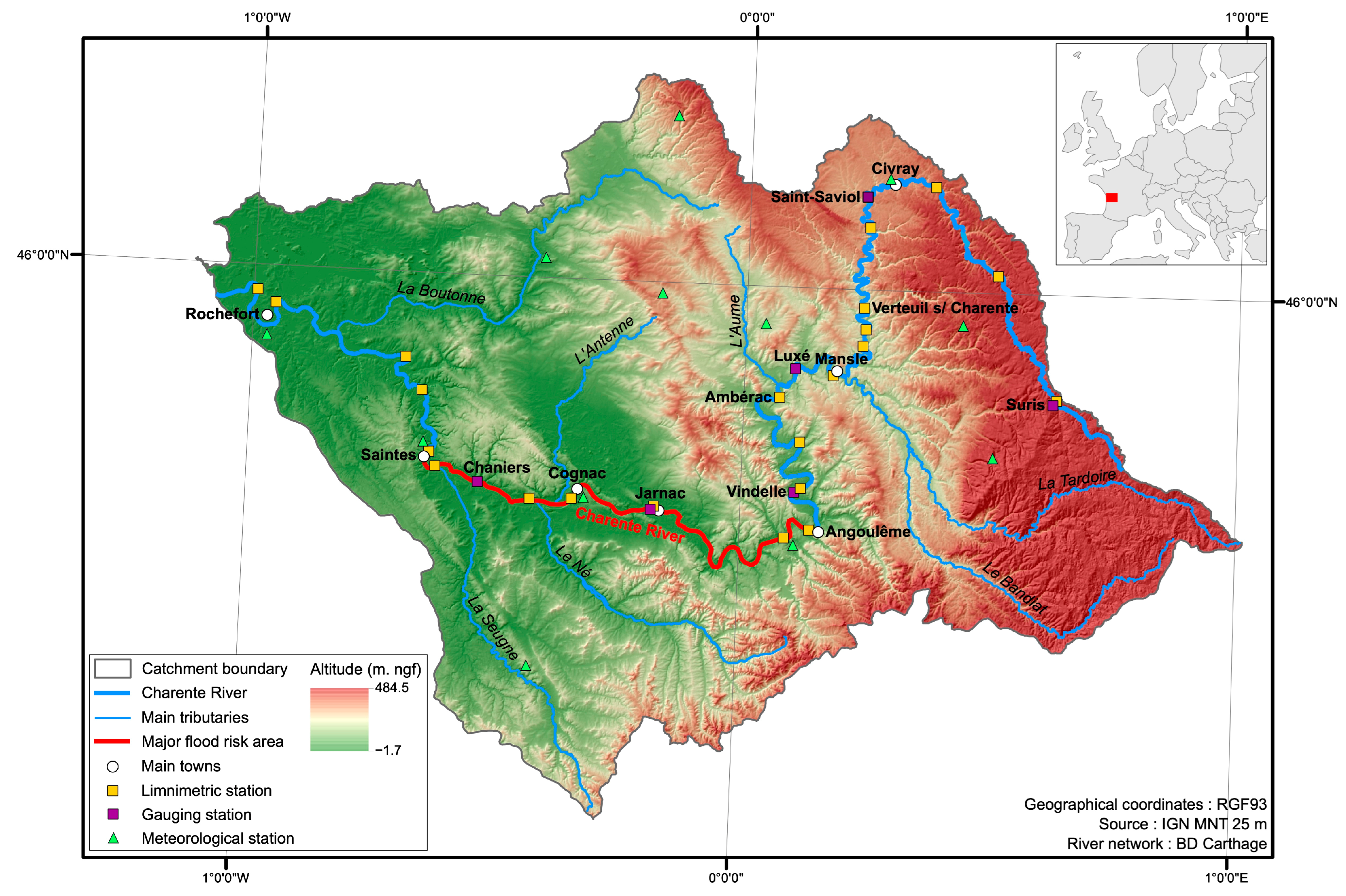

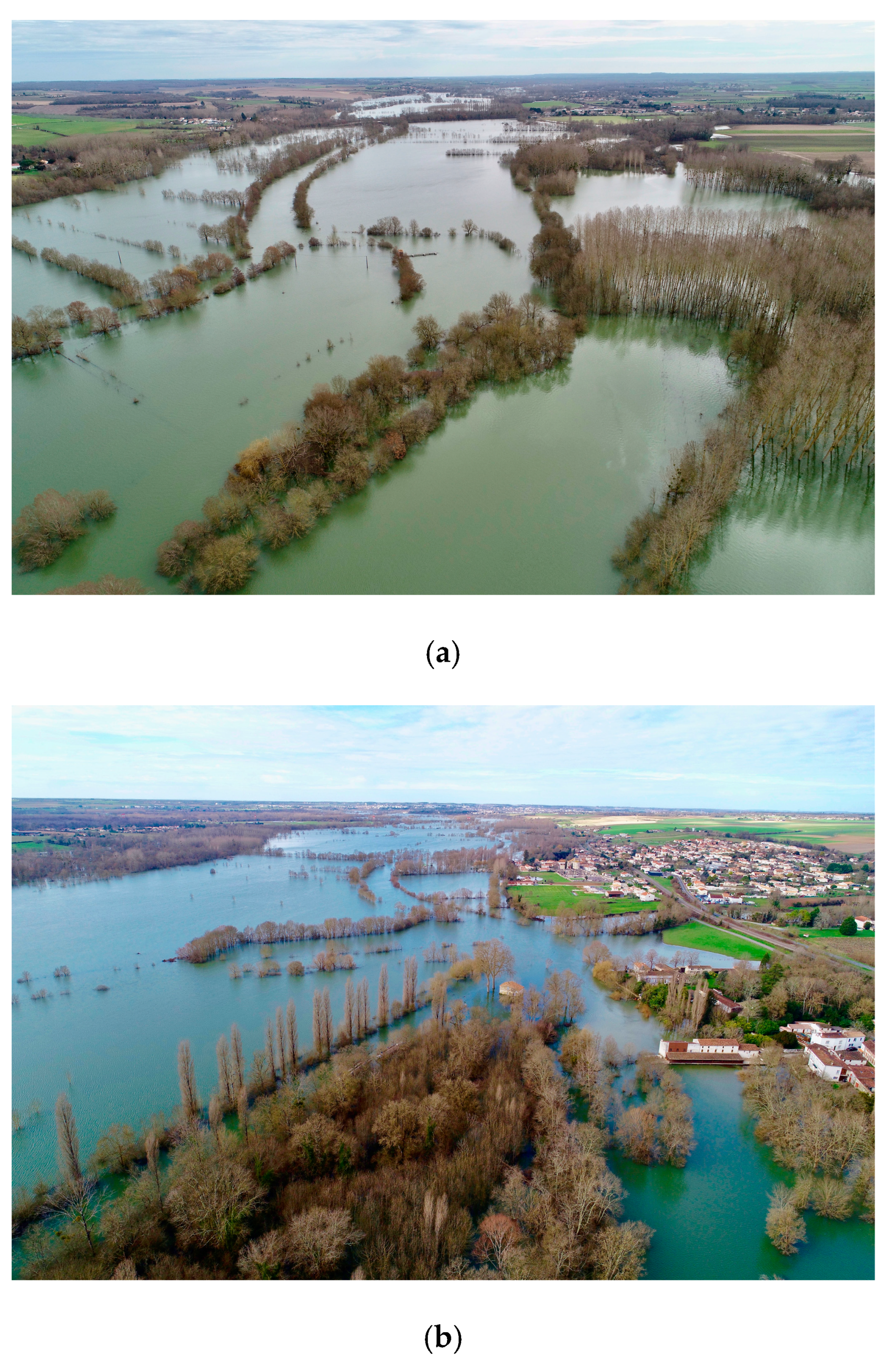
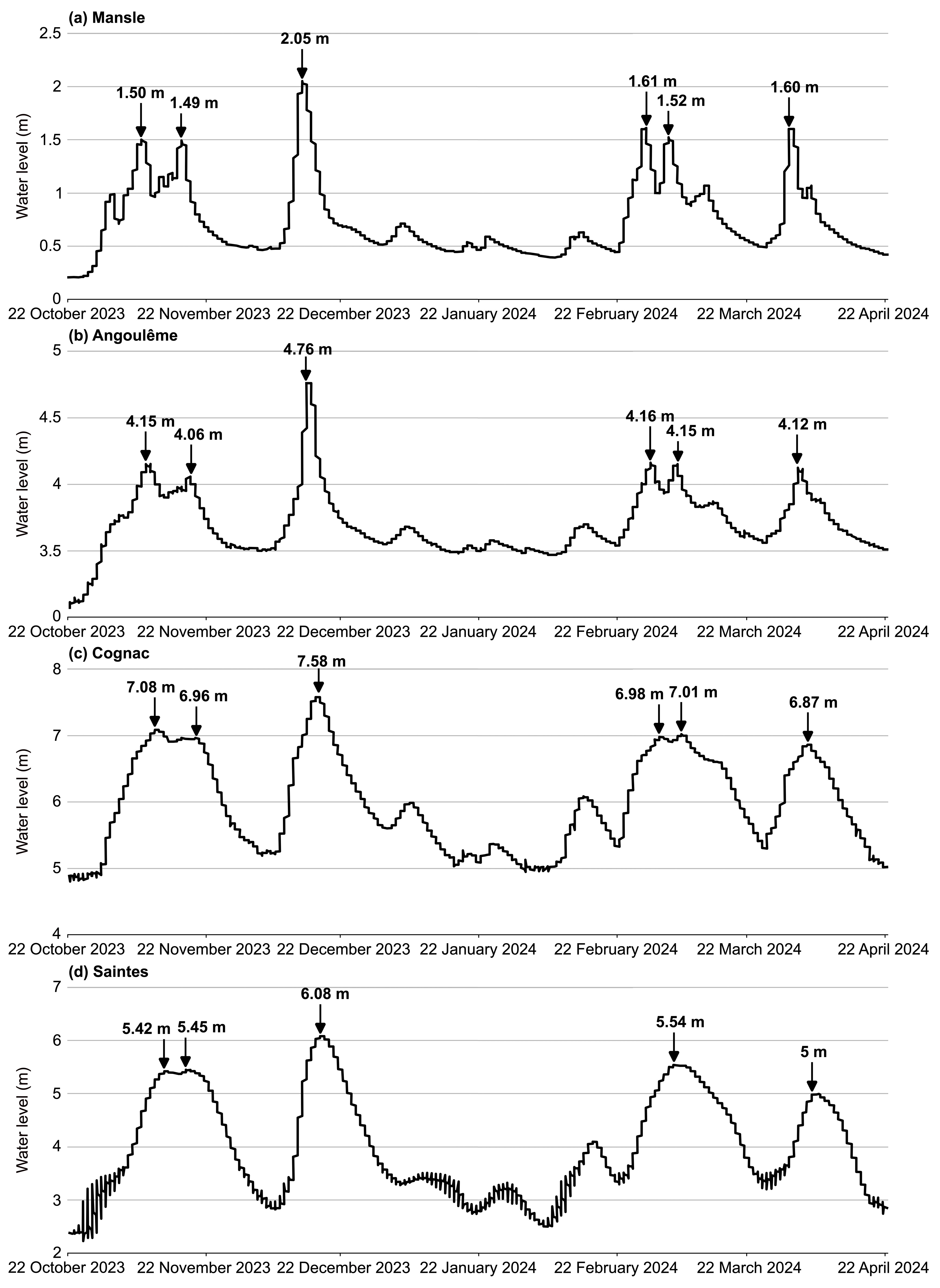
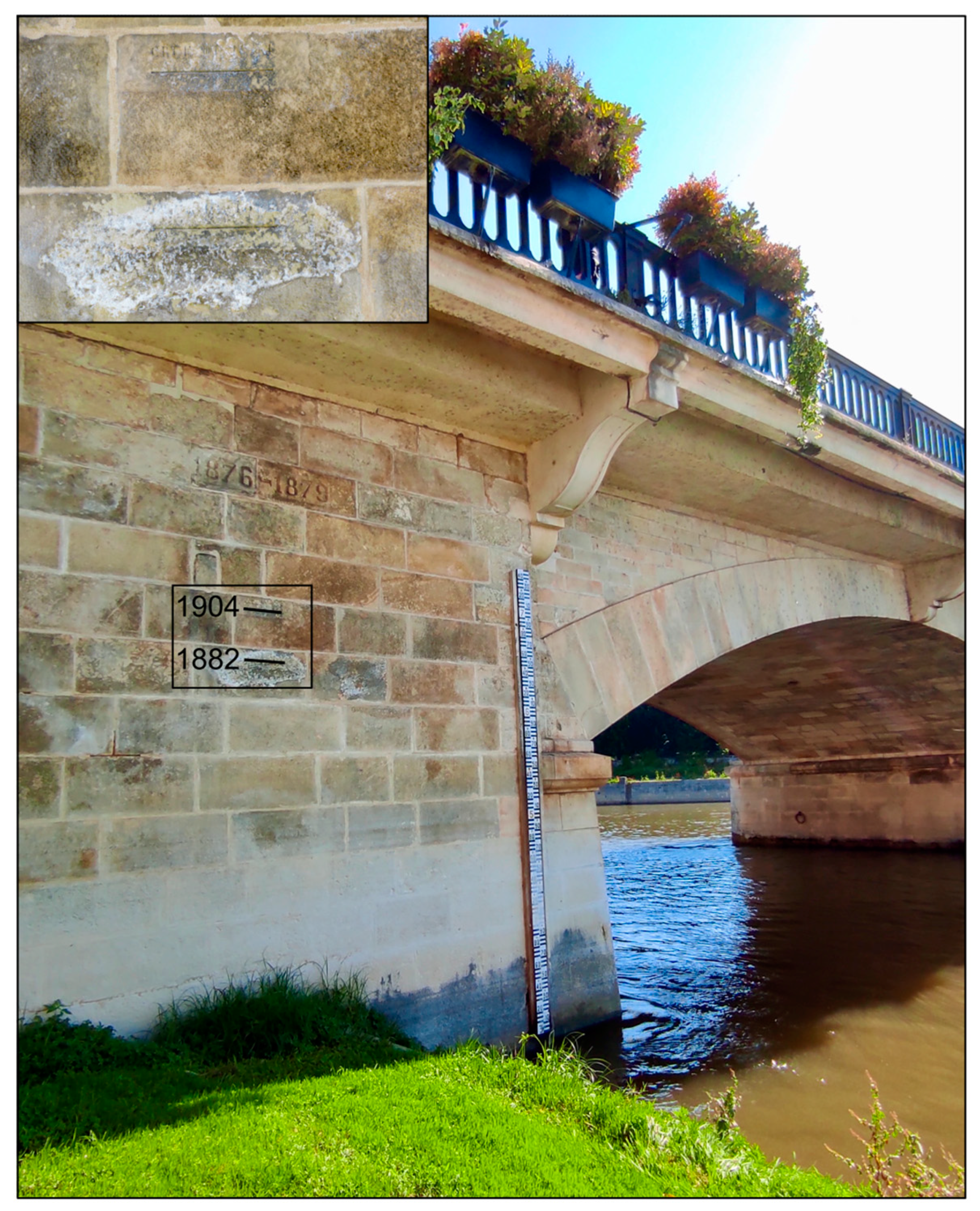
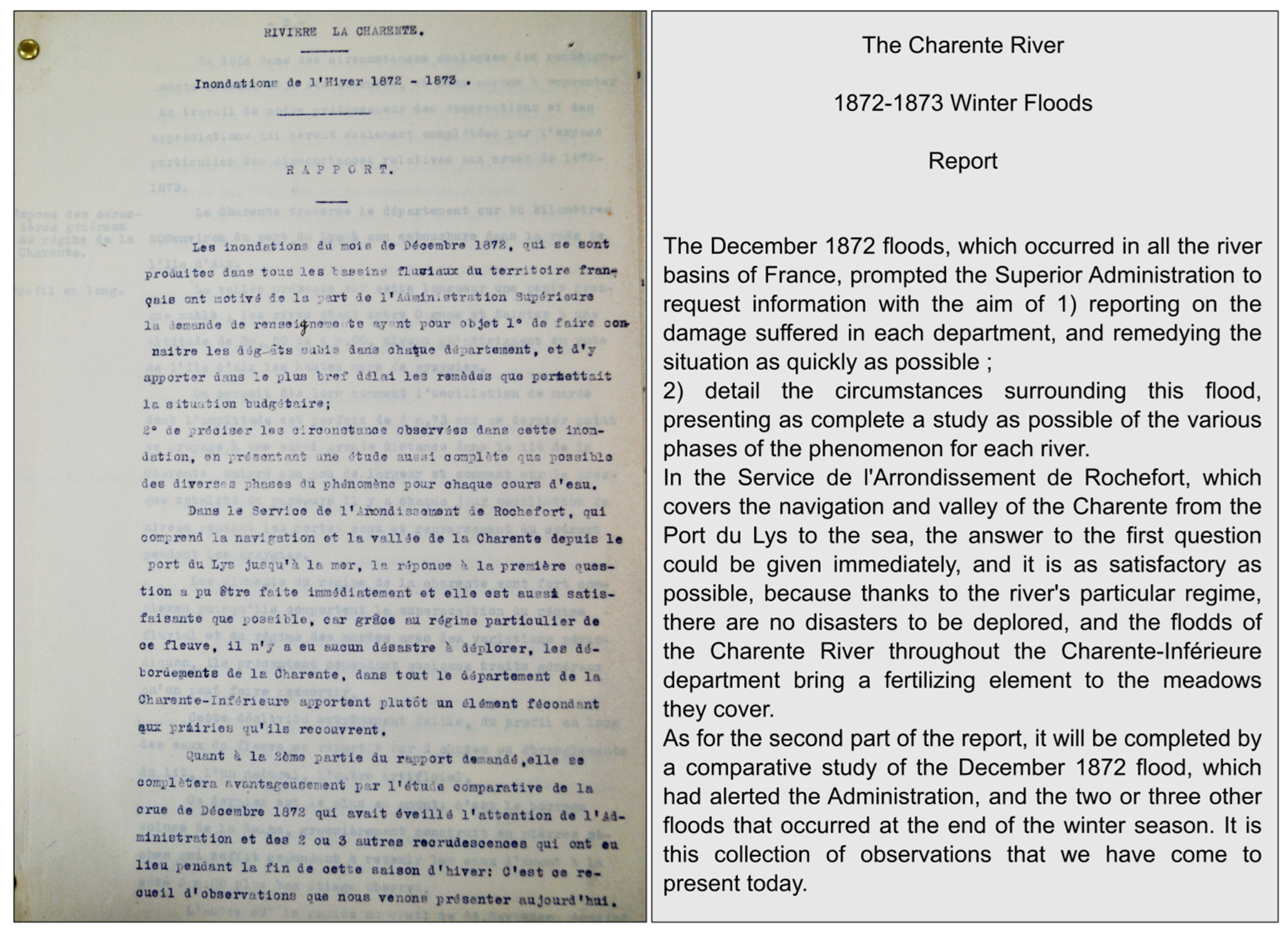

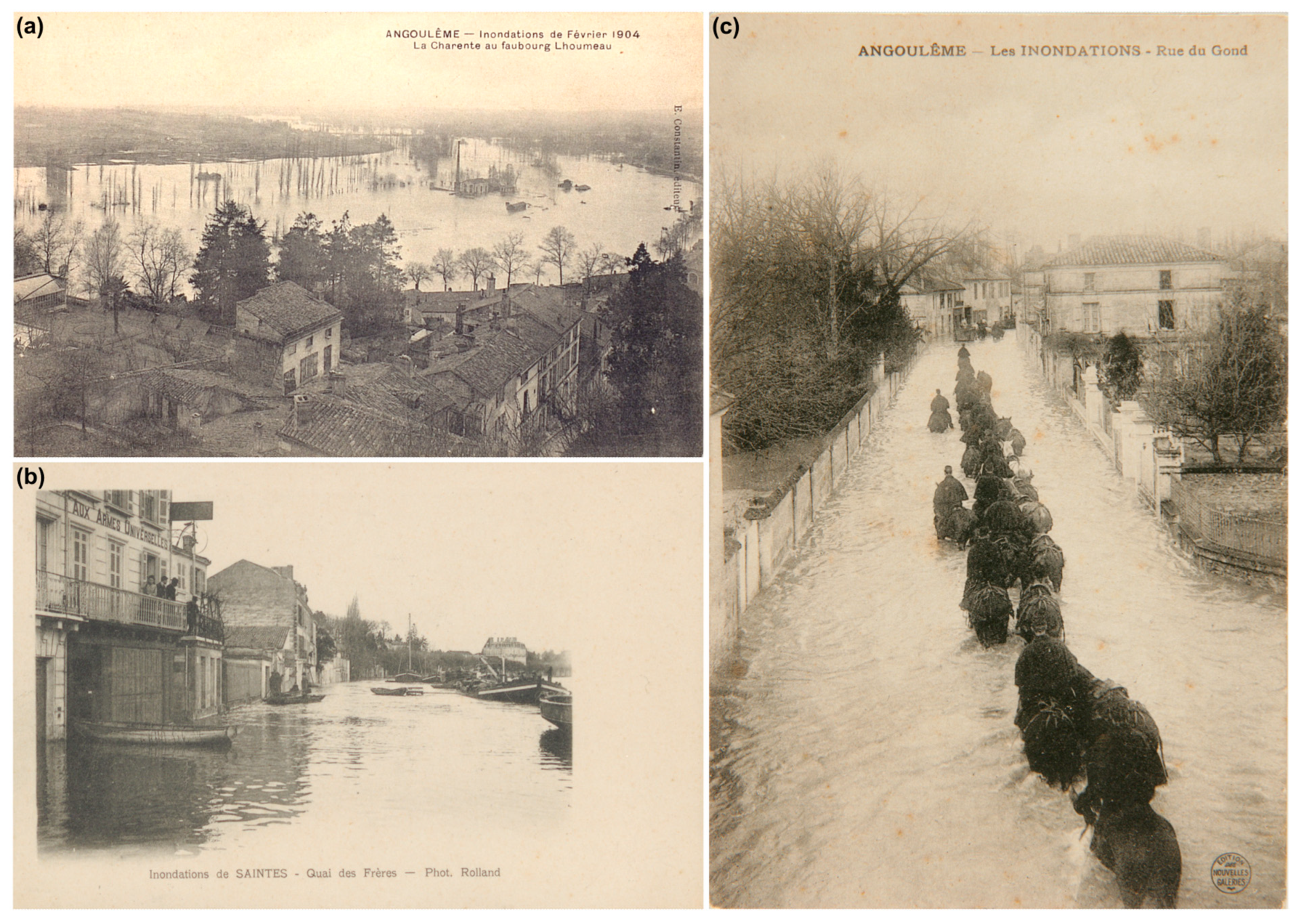
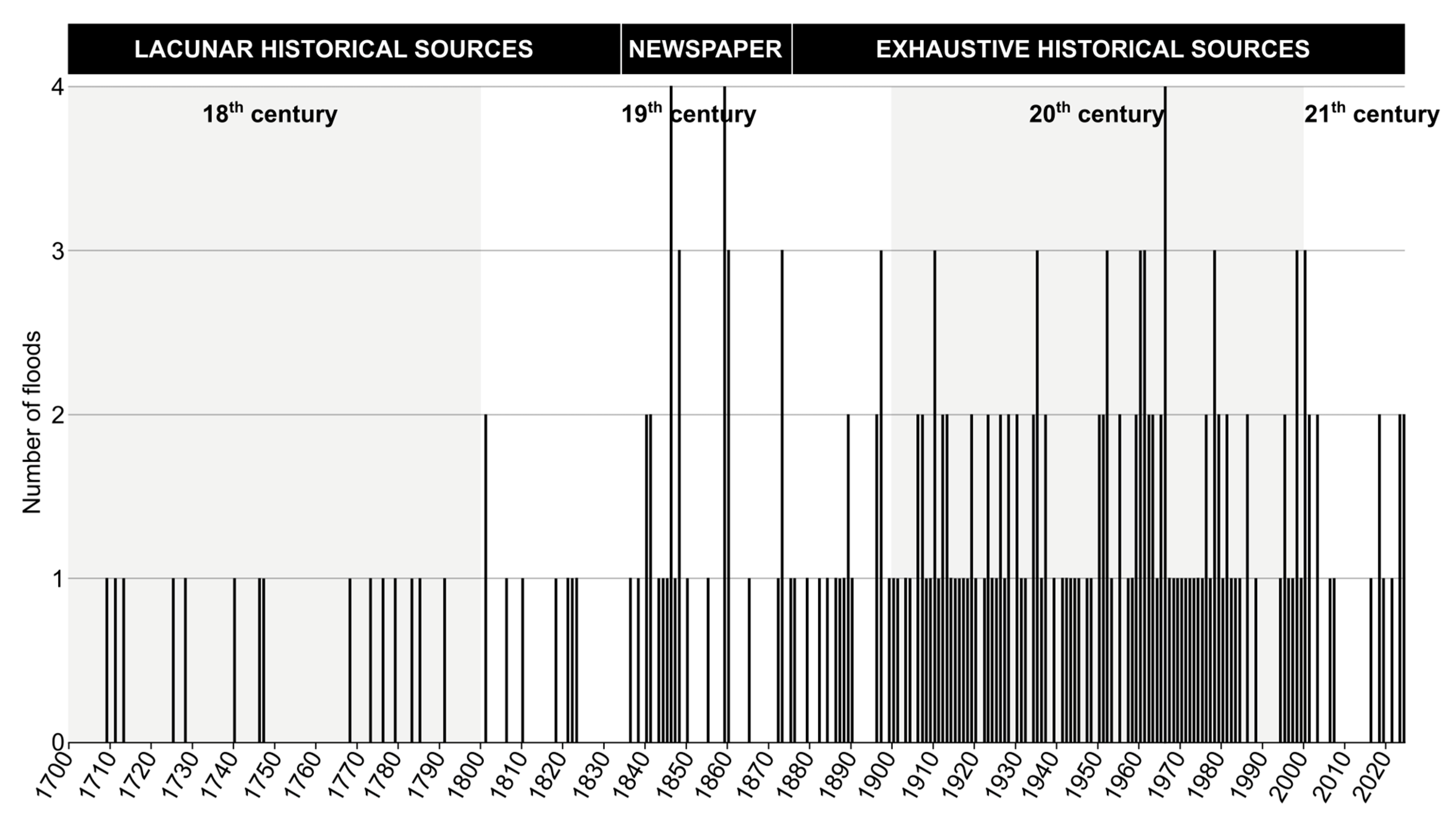

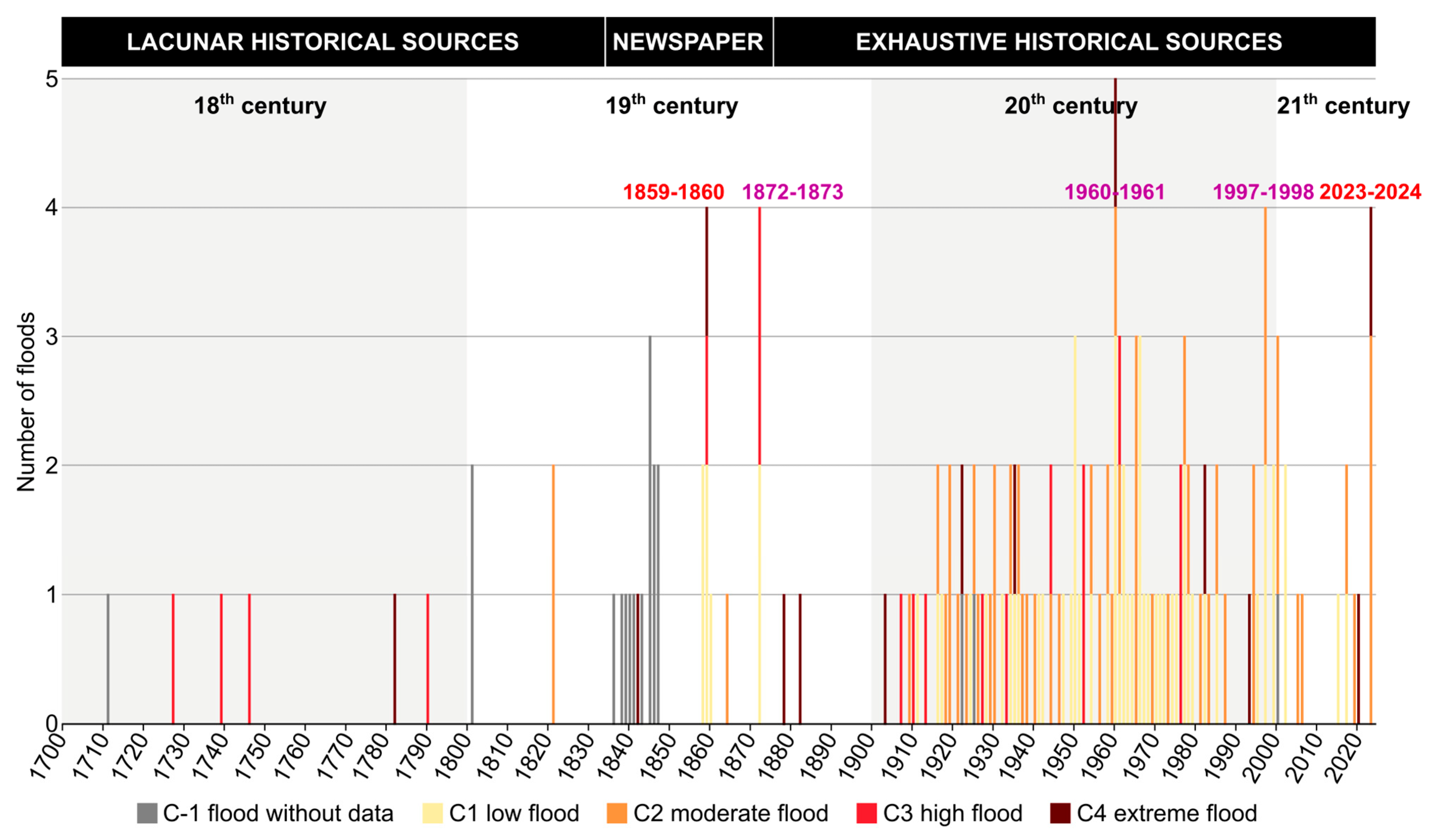
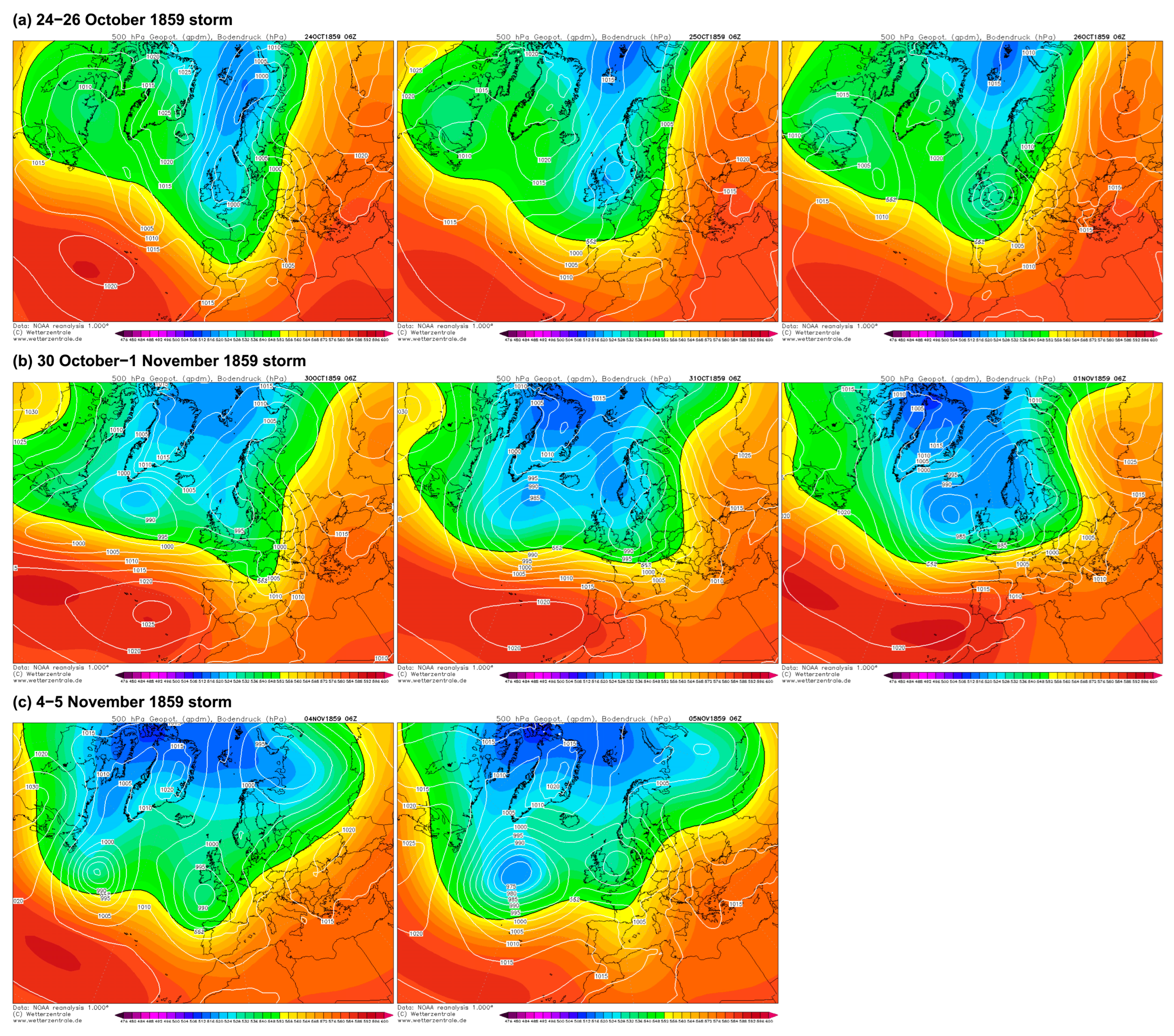
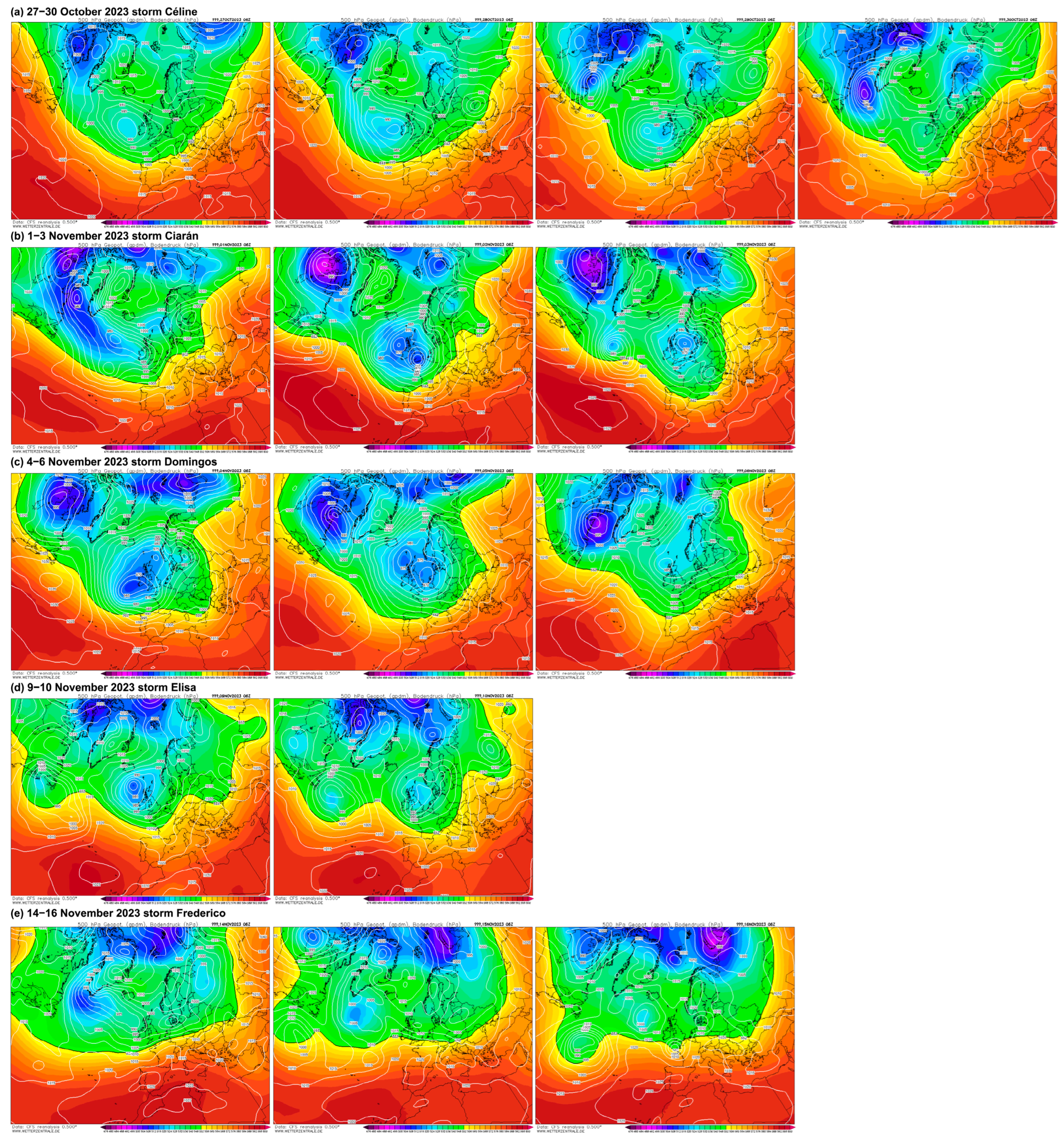
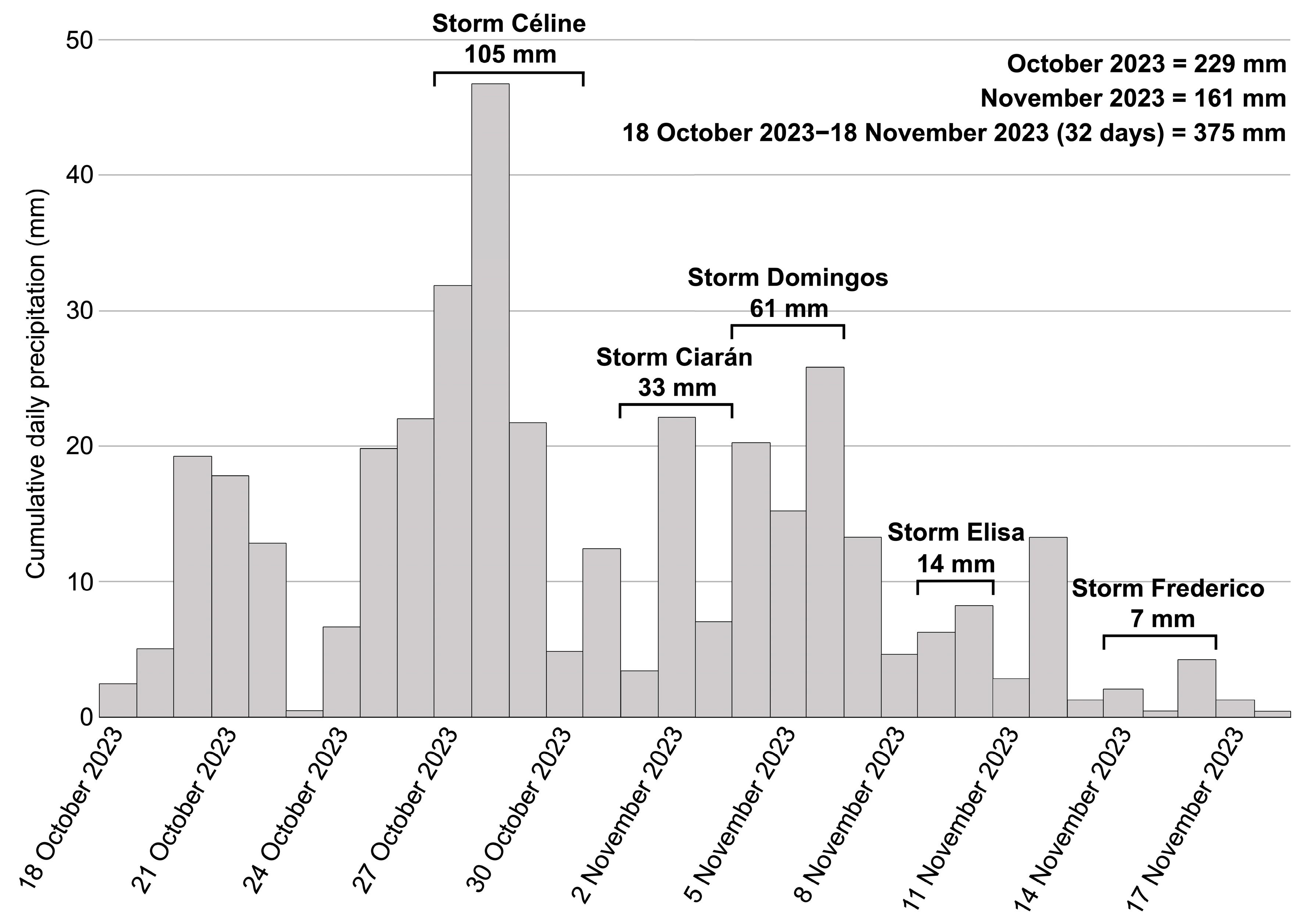
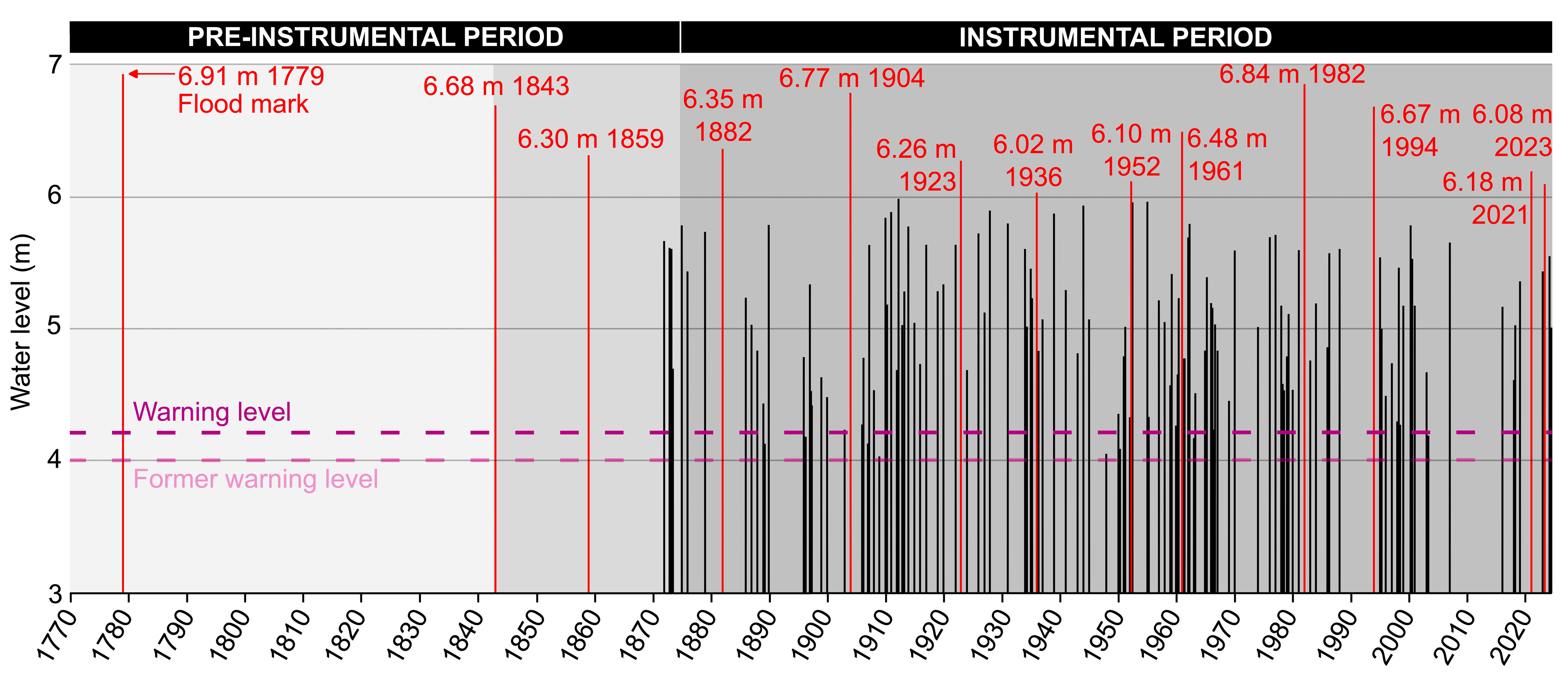
| Gauging Station | Suris | Vindelle | Angoulême | Jarnac | Chaniers | Saintes |
|---|---|---|---|---|---|---|
| Surface (km2) | 111 | 3722 | - | 4669 | 7412 | 7220 |
| Mean annual discharge (m3·s−1) | 14 | 30 | - | 64 | 65 | - |
| 2-year flood (m3·s−1) | 10 | 188 | - | 215 | 303 | 320 |
| 5-year flood (m3·s−1) | 17 | 289 | - | 273 | 448 | 450 |
| 10-year flood (m3·s−1) | 22 | 356 | 440 | 310 | 545 | 535 |
| 20-year flood (m3·s−1) | 26 | 420 | - | 343 | 637 | 620 |
| 50-year flood (m3·s−1) | 32 | 503 | 560 | - | - | 750 |
| 100-year flood (m3·s−1) | - | - | 645 | - | - | 815 |
| Calculation Period | 1991–2024 | 1977–2020 | - | 1990–2021 | 2004–2024 | - |
| Meteorological Station | Latitude | Longitude | Altitude | Systematic Measurements |
|---|---|---|---|---|
| Cognac | 45.665000 | −0.315833 | 30 | 1946–2024 |
| La Couronne | 45.627833 | 0.099833 | 58 | 1976–2024 |
| Montemboeuf | 45.787167 | 0.543000 | 247 | 1990–2024 |
| Tusson | 45.949000 | 0.062167 | 88 | 1986–2024 |
| Le Vieux Cérier | 45.967500 | 0.442000 | 162 | 1990–2024 |
| Nuaillé-sur-Boutonne | 46.019833 | −0.406667 | 36 | 1933–2024 |
| Saint-Germain-de-Lusignan | 45.458333 | −0.409667 | 71 | 1969–2024 |
| Saintes | 45.761167 | −0.652000 | 38 | 1916–2024 |
| Villiers-Couture | 45.987500 | −0.152000 | 106 | 1962–2024 |
| Civray | 46.160333 | 0.298667 | 143 | 1990–2024 |
| Melle | 46.235000 | −0.151333 | 136 | 1989–2024 |
| Hydrological Station | River | Latitude | Longitude | Systematic Measurements |
|---|---|---|---|---|
| Mansle | Charente | 45.87736732 | 0.17996101 | 2005–2024 |
| Angoulême | Charente | 45.65311030 | 0.15309785 | 1916−2024 |
| Cognac | Charente | 45.68964247 | −0.33987427 | 1993−2024 |
| Saintes | Charente | 45.74707976 | −0.62972709 | 1875−2024 |
Disclaimer/Publisher’s Note: The statements, opinions and data contained in all publications are solely those of the individual author(s) and contributor(s) and not of MDPI and/or the editor(s). MDPI and/or the editor(s) disclaim responsibility for any injury to people or property resulting from any ideas, methods, instructions or products referred to in the content. |
© 2025 by the authors. Licensee MDPI, Basel, Switzerland. This article is an open access article distributed under the terms and conditions of the Creative Commons Attribution (CC BY) license (https://creativecommons.org/licenses/by/4.0/).
Share and Cite
Duquesne, A.; Carozza, J.-M. How Exceptional Was the 2023–2024 Flood Sequence in the Charente River (Aquitania, South-West France)? A Geohistorical Perspective on Clustered Floods. GeoHazards 2025, 6, 3. https://doi.org/10.3390/geohazards6010003
Duquesne A, Carozza J-M. How Exceptional Was the 2023–2024 Flood Sequence in the Charente River (Aquitania, South-West France)? A Geohistorical Perspective on Clustered Floods. GeoHazards. 2025; 6(1):3. https://doi.org/10.3390/geohazards6010003
Chicago/Turabian StyleDuquesne, Amélie, and Jean-Michel Carozza. 2025. "How Exceptional Was the 2023–2024 Flood Sequence in the Charente River (Aquitania, South-West France)? A Geohistorical Perspective on Clustered Floods" GeoHazards 6, no. 1: 3. https://doi.org/10.3390/geohazards6010003
APA StyleDuquesne, A., & Carozza, J.-M. (2025). How Exceptional Was the 2023–2024 Flood Sequence in the Charente River (Aquitania, South-West France)? A Geohistorical Perspective on Clustered Floods. GeoHazards, 6(1), 3. https://doi.org/10.3390/geohazards6010003





